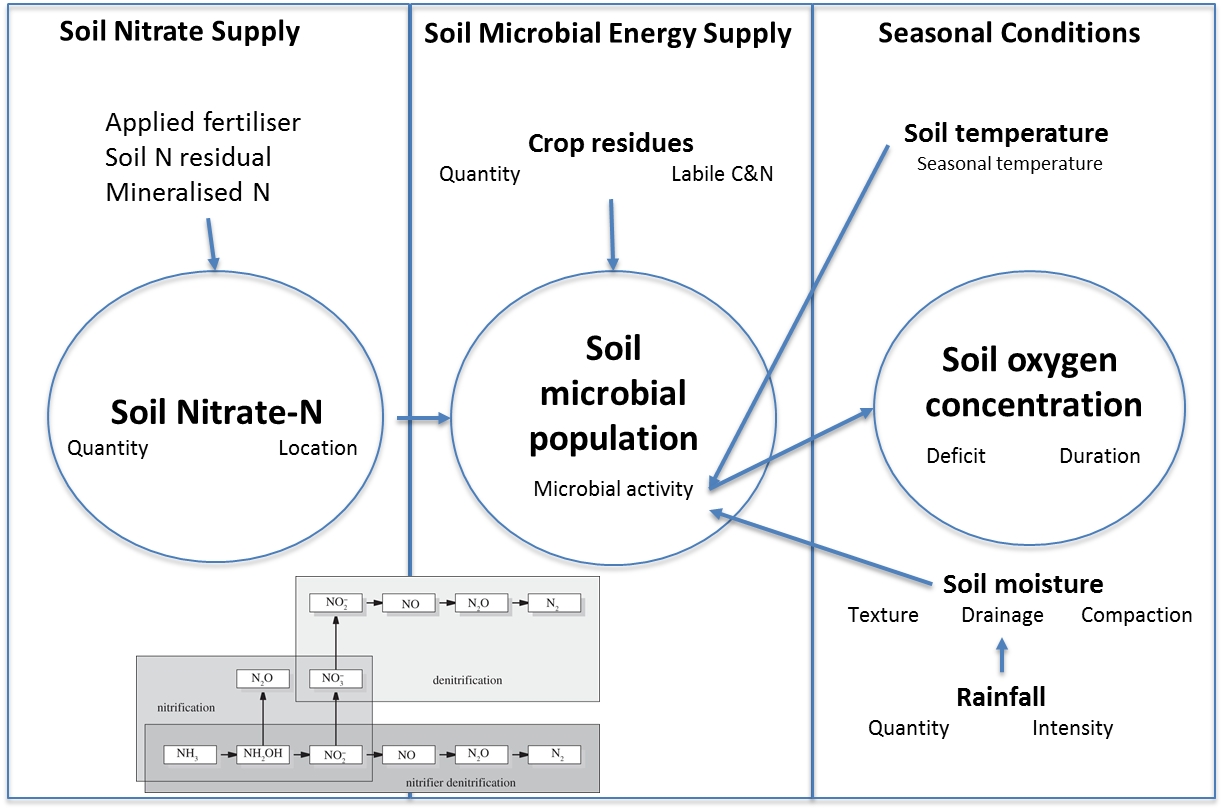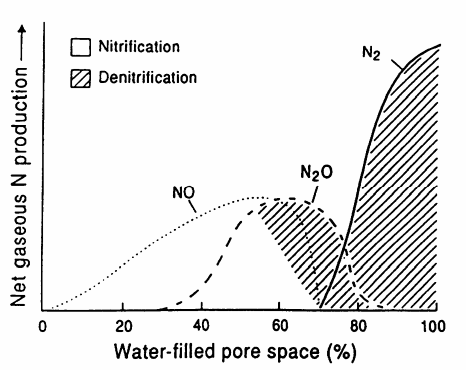Denitrification and managing nitrogen loss risk - key factors affecting loss
Author: Chris Dowling, Back Paddock Company | Date: 10 Mar 2017
Take home message
Denitrification N loss is an unavoidable soil process during crop production in the north. Understanding the key drivers and finding practical N management options in high risk situations or following a significant N loss event is the key to ensuring the economic impact of a denitrification event is minimised.
Background
Denitrification (Dn) risk is ever present in the clay soils of northern Australian grain growing areas. It cannot be eliminated, but by understanding the drivers of the process risk, mitigating N management tactics can be considered. The 5 core driving factors are
- Anaerobic soil conditions (severity and duration)
- Soil nitrate-N (quantity)
- Soil temperature
- Presence of key microbial species
- Availability of a labile carbon source (crop residues)

Figure 1. Relationship between key drivers of denitrification
The 5 key drivers are frequently present at levels in clay soils of northern grain growing regions where the main trigger, an anaerobic soil event (most commonly high moisture content), means that loss is unavoidable. Seasonal losses even in “dry season” can be around 10 % or the total seasonal crop N supply (Pu et al. 2001). Recent research suggests that losses of 20 – 50 % of applied N can occur in a single loss event. For any single Dn event the amount of N loss is related to the starting level of each of core driving factors and the duration of anaerobic soil condition. The total N loss across a cropping year is the accumulated loss of individual Dn events.

Figure 2. Model of the relationship between water-filled pore space of soil and relative fluxes of N-gases (Yoshinari 1993)
Minimisation of Dn loss is therefore a risk management process, with the key tactic being avoidance the creation of high levels of soil nitrate-N in a situations where risks associated with the other core drivers are high.
Table 1. Rating denitrification risk
|
Dn Risk factor |
Higher Risk |
Lower Risk |
|
N source |
N source rapidly converts to nitrate-N e.g. rapidly mineralisable fertiliser N |
N source converts sequentially with increasing fallow and in-crop moisture accumulation e.g. pulse residues |
|
N Timing |
Soil profile > 75 % full leading into high intensity rainfall period Fallow |
Soil profile <25 % full In - crop |
|
N Placement |
Broadcast into crop residue incorporation layer |
Banded below stubble incorporation layer |
|
N Rate |
All fertiliser N applied in one application |
Split N into lower risk periods Increase N from higher efficiency sources |
|
Drainage |
< 1% Dispersive |
>5% |
|
Labile carbon |
Large amount from previous crop Early fallow |
Small amount from previous crop Late fallow |
|
Soil temperature |
Summer |
Winter |
Accurately predicting and modelling the Dn is complex and is still not at a level where simple, reliable decision support tools are currently available. Preventing negative economic effects of Dn events is currently about weighing up the likely loss based on the risk factors (Table 1), assessing factors such stage of crop season, crop condition, potential cost and returns and taking appropriate action.
Loss during the fallow can also be confirmed by soil testing for soil nitrate-N (0-60 cm) close to planting or early in- crop. Recent experience with soil testing post waterlogging and a rapid large N mineralisation event (e.g. first decent autumn rainfall after a dry summer) suggests that testing should be delayed for 4 – 6 weeks after end of waterlogging event to allow sufficient time for the soil to settle to a new nitrate-N equilibrium (https://extensionhub.com.au/web/crop-nutrition/-/how-to-include-ammonium-n-in-recommendations).
Having a higher proportion of crop N supply provided from mineralisable N sources is a valuable mitigation strategy as are getting nitrate-N deeper in the profile and splitting application timing.
Acknowledgement
The information presented is made possible through the support of the GRDC, the author would like to thank them for their continued support.
References
Pu G, Strong WM, Saffigna PG, Doughton J. 2001 Denitrification, leaching and immobilisation of applied 15N following legume and grass pastures in a semi-arid climate in Australia. Nutrient Cycling in Agroecosystems. Volume 59, Issue 3, pp 199–207.
Yoshinari, T. 1993. Nitrogen oxide flux in tropical soils. TREE. 8:155-156.
Contact details
Chris Dowling
Back Paddock Company
PO Box 823
Cleveland, Q, 4163
Ph: 0407 692 251
Email: cdowling@backpaddock.com.au
GRDC Project Code: DAQ00183,
Was this page helpful?
YOUR FEEDBACK
